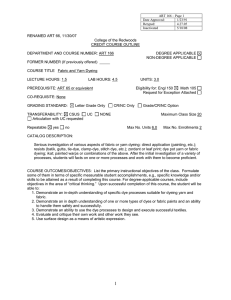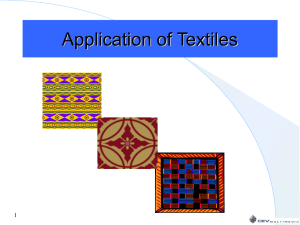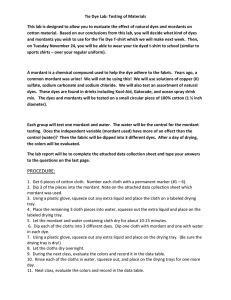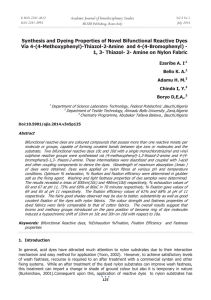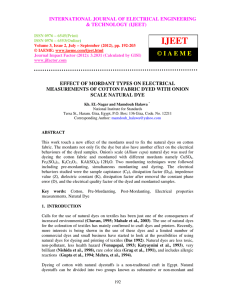Dyeing fabrics - Fiber, Fabric & Fashion
advertisement
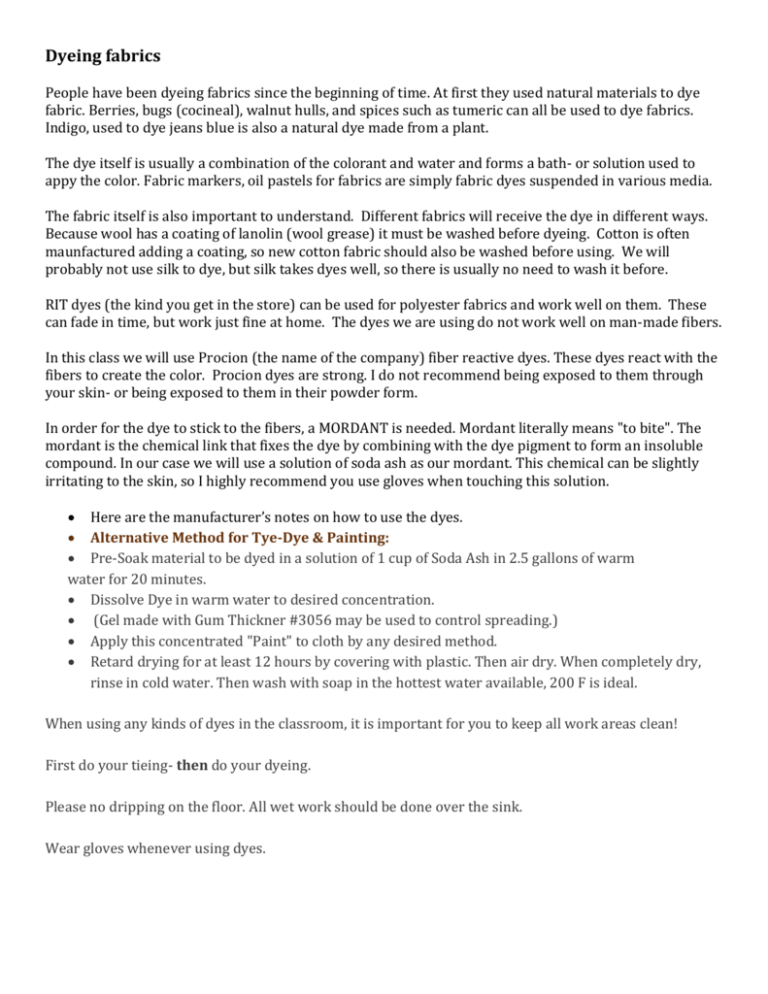
Dyeing fabrics People have been dyeing fabrics since the beginning of time. At first they used natural materials to dye fabric. Berries, bugs (cocineal), walnut hulls, and spices such as tumeric can all be used to dye fabrics. Indigo, used to dye jeans blue is also a natural dye made from a plant. The dye itself is usually a combination of the colorant and water and forms a bath- or solution used to appy the color. Fabric markers, oil pastels for fabrics are simply fabric dyes suspended in various media. The fabric itself is also important to understand. Different fabrics will receive the dye in different ways. Because wool has a coating of lanolin (wool grease) it must be washed before dyeing. Cotton is often maunfactured adding a coating, so new cotton fabric should also be washed before using. We will probably not use silk to dye, but silk takes dyes well, so there is usually no need to wash it before. RIT dyes (the kind you get in the store) can be used for polyester fabrics and work well on them. These can fade in time, but work just fine at home. The dyes we are using do not work well on man-made fibers. In this class we will use Procion (the name of the company) fiber reactive dyes. These dyes react with the fibers to create the color. Procion dyes are strong. I do not recommend being exposed to them through your skin- or being exposed to them in their powder form. In order for the dye to stick to the fibers, a MORDANT is needed. Mordant literally means "to bite". The mordant is the chemical link that fixes the dye by combining with the dye pigment to form an insoluble compound. In our case we will use a solution of soda ash as our mordant. This chemical can be slightly irritating to the skin, so I highly recommend you use gloves when touching this solution. Here are the manufacturer’s notes on how to use the dyes. Alternative Method for Tye-Dye & Painting: Pre-Soak material to be dyed in a solution of 1 cup of Soda Ash in 2.5 gallons of warm water for 20 minutes. Dissolve Dye in warm water to desired concentration. (Gel made with Gum Thickner #3056 may be used to control spreading.) Apply this concentrated "Paint" to cloth by any desired method. Retard drying for at least 12 hours by covering with plastic. Then air dry. When completely dry, rinse in cold water. Then wash with soap in the hottest water available, 200 F is ideal. When using any kinds of dyes in the classroom, it is important for you to keep all work areas clean! First do your tieing- then do your dyeing. Please no dripping on the floor. All wet work should be done over the sink. Wear gloves whenever using dyes. Dyeing Instructions 1. Identify your fiber content. These should be plant-based fibers such as cotton, rayon or bamboo. Any completely new fabrics (such as new t-shirts) should be prewashed. 2. Write your name in sharpie on each swatch. 3. Tie your fabric tightly with rubber bands or polyester cord. You have enough fabric to try 3-4 of these techniques. TIE DYE See blog for handout Knot tying Spirals Electric Bunching Rosettes Stripes Diamonds/Ovals/Squares Circles Pleats Or- for the student who is bored with traditional tye-dye – look at the Japanese tradition of SHIBORI. There are plenty of links on the blog. This gives AMAZING results. You may need to bring in some sticks or stones or flat shaped objects. Arashi- (Japanese for “storm”) shibori a pole-wrapping technique. The cloth is wrapped on a diagonal around a pole or cylindrical object and then tightly bound by wrapping thread or wire up and down the pole. Next, the cloth is scrunched down on the pole. The patterns are on a diagonal in arashi shibori which suggests the rain from a heavy storm. For a small piece of fabric- could a pencil be used as your pole? A stick would be great. Very Japanese! Kumo- Is a twist and bind-resist technique. This technique involves wrapping sections of the cloth over a found object, usually small stones or pebbles (or coins!) . Then the cloth is bound in very close sections with rubber bands. The result is a very specific circular spider-like design. Itajime- Is a shape-resist technique. The cloth is folded like an accordion and sandwiched between two pieces of wood or any flat shaped object, which are held in place with string or rubber bands. The shapes prevent the dye from penetrating the fabric they cover and give an endless variety of patterns depending on the fold, binding object and placement of rubber bands. Maybe use popsicle sticks for your flat objects. 4. Soak in a bath of 1 cup soda ash to 2.5 gallons of water (BEFORE DYEING) for 20 minutes. USE GLOVES! 5. Using gloves, apply dye solution with a squeeze bottle, making sure you catch excess dye into a vat- to be re-used. Please use lighter colors first. AVOID PUTTING COMPLEMENTARY COLORS NEXT TO ONE ANOTHER, AS THE RESULT WILL BE A TERRIBLE BROWN. 6. Place dyed fabrics into a Ziplock bag. Keep them there and untouched for 2-24 hours. ( According to manufacturer’s instructions, for best results, fabrics should be air dried before rinsing. ) 7. Rinse in cold water until water runs clean. Make sure you wear gloves for this process. 8. Dry at home! NO DRIPPPING!



